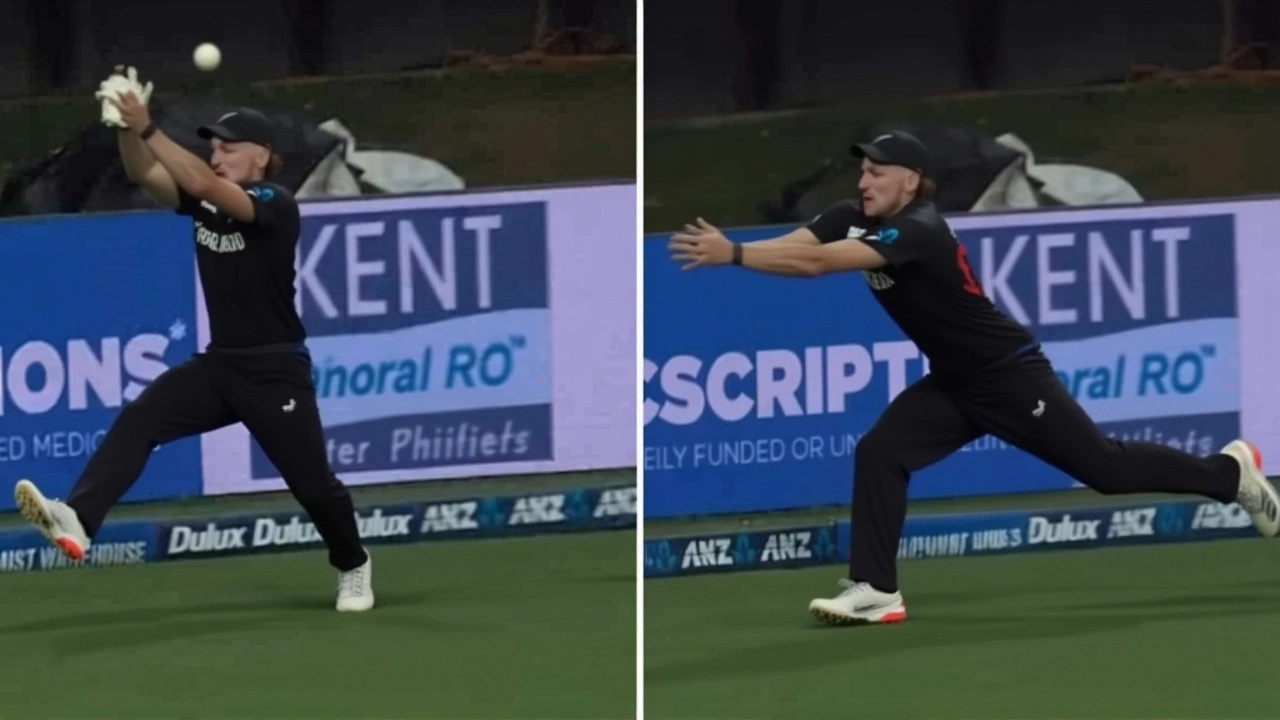
When New Zealand posted 344 for 9 against Pakistan at McLean Park on Saturday, March 29, 2025, no one expected the collapse that followed. But that’s exactly what happened. Pakistan, chasing 345, looked poised for a historic run chase—until Nathan Smith turned the game on its head. The result? A 73-run win for New Zealand, giving them a 1-0 lead in the three-match ODI series. It wasn’t just a victory. It was a statement.
Chapman’s Masterclass Anchors New Zealand’s Total
New Zealand’s innings began with a wobble—three quick wickets inside 12 overs had fans holding their breath. But then came Mark Chapman. The 28-year-old middle-order batter, often overlooked in international circles, delivered the performance of his life. His 132 off 111 balls wasn’t just about runs; it was about timing, temperament, and terrorizing Pakistan’s spinners. He mixed elegant cover drives with brutal pulls, reaching his century in just 89 balls. His partnership with Daryl Mitchell (76 off 84) was the backbone of the innings, adding 150 runs in under 15 overs. Even more impressive? They did it while navigating the tricky middle overs, where Pakistan had hoped to strangle the scoring.Debutant Muhammad Abbas added fireworks at the death, smashing 52 off just 26 balls—six fours and three sixes. His cameo took New Zealand from 290 for 7 to 344 for 9, a brutal reminder that even the tail can bite when the pitch is flat and the fielding is lax.
Pakistan’s Chase: Hope, Hesitation, and Collapse
Pakistan’s reply started with promise. Openers Abdullah Shafique and Usman Khan raced to 50 in 45 balls. Then came Babar Azam, Pakistan’s talisman, who looked in sublime touch—78 off 83 balls, elegant and composed. For a while, it felt like he might carry them home.Enter Salman Agha. The young opener, playing only his sixth ODI, smashed 58 off 48—his sixth international fifty. He was hitting boundaries with ease. Then came the drop. On 56, Michael Bracewell spilled a straightforward catch at mid-off. It should’ve been game over. Instead, it became the calm before the storm.
At 250 for 4 in the 39th over, Pakistan needed just 95 off 66 balls. The equation looked manageable. But then Nathan Smith bowled his third over. The first ball was a short one. Haris Rauf went for the big hit. Top edge. Caught by Henry Nicholls at mid-wicket. The crowd gasped. The scoreboard blinked: 253 for 5.
Three balls later, Agha tried to loft Jacob Duffy over mid-off. Too much power. Too little control. Bracewell, diving full length, snatched it clean. The stadium erupted. 261 for 6. The momentum had flipped.

Smith’s Four-Fer Seals the Deal
Nathan Smith didn’t just take wickets—he dismantled confidence. His final figures—4 for 60 in 8.1 overs—were the most economical four-wicket haul in ODI history at McLean Park. He didn’t rely on pace. He relied on line, length, and subtle changes of pace. His final wicket? Akif Javed, heaving a full toss to deep mid-wicket where Will O'Rourke took the catch with ease. The ball was still in the air when the crowd started chanting. When it landed? Silence. Then, pandemonium.What made it worse for Pakistan? Two failed reviews. One, in the 41st over, overturned a caught-behind decision against Daryl Mitchell. The other, in the 42nd over, challenged Smith’s dismissal of Rauf—only for UltraEdge to show no contact. New Zealand had used their reviews wisely. Pakistan had wasted theirs.
What This Means for the Series
This wasn’t just a win. It was a psychological blow. Pakistan entered this series as underdogs, but few thought they’d be so thoroughly outplayed. New Zealand, meanwhile, have shown they’re not just a home-side team—they’re a team with depth, composure, and the ability to win under pressure. The second ODI on April 2, 2025, at Eden Park, is now a must-win for Pakistan. Lose again, and the series is effectively over.For New Zealand, the focus shifts to consistency. Chapman’s performance was brilliant, but can he replicate it? Can Smith sustain this form? And will the middle order—often their Achilles’ heel—step up again?

Behind the Numbers
- New Zealand’s 344/9 was their highest ODI total against Pakistan in New Zealand since 2018. - Babar Azam’s 78 was his 42nd ODI fifty, but his lowest strike rate in a fifty this year (93.97). - Nathan Smith’s 4/60 was his first ODI four-wicket haul—and the best bowling figures by a New Zealander at McLean Park since 2017. - Pakistan’s collapse from 250/4 to 271 all out is their worst in the final 10 overs of an ODI chase since 2022. - Only two successful reviews in the match—both involving key dismissals—highlighted the growing role of technology in modern ODI cricket.Frequently Asked Questions
How did Mark Chapman’s performance compare to past ODI innings in New Zealand?
Chapman’s 132 was the highest individual score by a New Zealander in an ODI against Pakistan on home soil since Ross Taylor’s 141 in 2015. It was also the fastest century by a Kiwi batter against Pakistan in New Zealand, surpassing Kane Williamson’s 100 off 117 balls in 2019. His strike rate of 118.91 was the highest for any New Zealand batter scoring over 120 in a chase against Pakistan.
Why did Pakistan’s middle order fail despite Babar Azam and Salman Agha’s fifties?
Pakistan’s middle order lacked aggression and adaptability. After Agha’s dismissal, the next three batters—Rauf, Javed, and Shaheen Afridi—combined for just 17 runs off 29 balls. They were all looking to hit boundaries instead of rotating strike, which played into Smith’s hands. New Zealand’s field placements were tight, and Pakistan’s lack of rotation turned pressure into panic.
What role did the pitch at McLean Park play in the outcome?
The pitch was flat and true—ideal for batting. But it slowed down slightly after the 30th over, making spin more effective. New Zealand’s decision to bowl first was bold, but it paid off because their spinners, especially Smith, exploited the grip in the middle overs. Pakistan’s bowlers, used to faster tracks at home, struggled to adjust their line and length.
How crucial is the next ODI in Auckland for Pakistan’s chances?
Extremely. Pakistan hasn’t won a three-match ODI series in New Zealand since 2011. If they lose the second match at Eden Park, they’ll need to win the final game by a massive margin to level the series—something they haven’t done in any away ODI series since 2018. The psychological pressure on their batting lineup will be immense.
Is Nathan Smith now a key player for New Zealand’s future?
Absolutely. At 26, Smith has now taken 14 wickets in his last five ODIs at an average of 18.2. He’s the first New Zealand spinner since Daniel Vettori to take multiple four-wicket hauls against Pakistan. With Mitchell Santner’s form inconsistent, Smith is emerging as the go-to option in the middle overs—a role that could define New Zealand’s campaign for the 2027 World Cup.
What’s the historical significance of this win for New Zealand?
This was New Zealand’s largest margin of victory over Pakistan in an ODI in New Zealand since 2001, when they won by 87 runs. It also marks the first time since 2016 that New Zealand has won an ODI by more than 70 runs while bowling first. More importantly, it’s the first time in 12 years they’ve won the first match of a three-game ODI series against Pakistan and gone on to win the series.
Leave a comments